The highly dynamic crypto industry depends on online visibility for attracting potential customers. Thus, an efficient SEO strategy is paramount for maximizing the return on investment (ROI). It’s clear that crypto businesses should prioritize SEO, but how do you build an effective SEO budget strategy for such a competitive landscape? In this article, we’ll provide you with practical tips on developing an effective budget for SEO that will make the most of your marketing investment.
Setting the Stage: The Current State of Crypto SEO
As you start to promote your own brand, it is important to understand your goals and have a deep knowledge of your niche. If you think about creating a budget for a crypto website, you should, first of all, find out who your competitors are and what resources they invest to achieve the necessary results.
Moreover, if you are doing a comprehensive promotion for your project, your marketing strategy will most likely not be focused solely on SEO. You will want to involve different traffic sources for your brand promotion. Thus, to build an SEO budget, it is necessary to determine your total digital marketing budget and decide on which marketing channels will be used in combination with search engine optimization.
The Role of SEO in Crypto Business Growth
Starting a crypto-related business comes with challenges of different kinds. Once you enter the market, you’ll face high competition, regulatory uncertainties, limited online advertising opportunities caused by them, fluctuating trends, and a high threshold for gaining trust and credibility. From the point of view of search engine optimization, several more specific issues can influence your business growth:
- Technical Optimization: You will have to perform a technical SEO audit of your website, which can determine different issues that will have to be addressed to be on par with your competitors.
- Link Building Strategies: Competitors with well-established brand names will have more backlinks, especially organic ones, thanks to their popularity.
- Content Quality and On-Page Optimization: The creation and optimization of content related to cryptocurrencies require serious investment and deep research.
- Constant Updates and Algorithm Changes: Google and other search engines regularly update their algorithms, so you’ll have to revise your strategy according to core updates and other changes from time to time.
In order to create an SEO strategy that accounts for the challenges, you’ll need to do a thorough analysis of your field. The Crypto SEO agency can help you conduct thorough research within the Niche Analysis service.
The Foundation: Building Your Crypto SEO Budget
The basic principles of creating an SEO budget for a crypto website are the same as those for other projects. However, there are some nuances that you should consider.
To start developing your own digital marketing budget, you will need to determine the main business objectives that this project will aim to fulfill. Then, it’s necessary to do a niche analysis, study your competitors, evaluate your chances of success, and analyze all the nuances of competitors’ promotion methods. Lastly, the data you will have gathered will help you determine the KPI (key performance indicators) and set achievable goals.
Assessing Your Business Goals and Objectives
It is crucial to assess your goals and objectives to make sure that your SEO strategies align with the overall business plan. A well-thought-out assessment allows you to distribute the resources effectively and helps you measure ROI by comparing the initial objectives with the results of the promotion.
Let’s take a large crypto exchange as an example. First, we need to understand who will use it and what revenue we can expect, especially considering the niche and the traffic it will generate. Then, we should take a look at our current investment and calculate how much traffic (the number of leads and the average revenue per lead) we’ll need to get a positive return on investment.
Next, we should determine how much organic traffic we’ll need per month and estimate the amount of time necessary for the investment to pay off. This estimation should include different traffic channels – social media, ads, SEO, etc. Finally, we should set the main goals, including pessimistic, realistic, and optimistic ones.
Researching Keyword Trends and Competitor Analysis
Crypto SEO budgeting requires a thorough understanding of the demand for your services or products online, how the potential customers search for them in Google, and what needs you can meet. This can be determined by keyword research and competitor analysis.
Keyword research allows you to see how much traffic relevant keywords can bring to your website and which pages can generate the traffic. To determine this, take a look at the search engine result pages for your potential keywords and analyze what types of pages are ranking for them. For example:
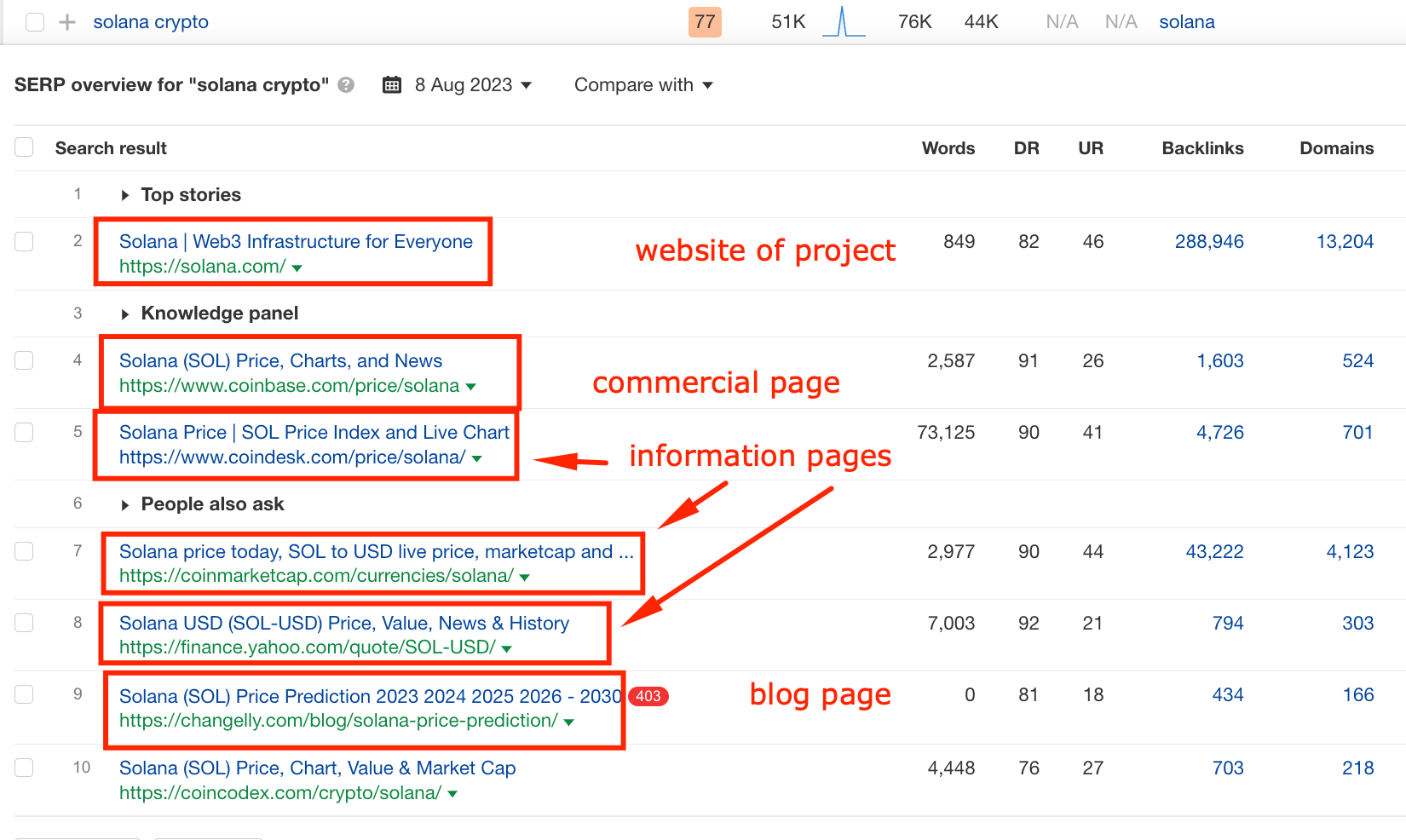
Search results analysis and selection of competitors in the cluster using Ahrefs
Once you determine the main keyword clusters and page types, analyze how your competitors rank for them. Draw conclusions on what should be done to reach the top rankings – what you should add to or remove from your website.
When looking at the clusters, you should assign different priority levels to your pages. Determine high-priority pages that are the most important to you, analyze the competition in this cluster, and calculate the resources you need to promote them.
Next, look at medium-priority pages with lower competition. The competitor pages for this cluster will be similar (the same types of pages). For example, the keywords ‘exchange Bitcoin’ and ‘exchange Ethereum’ will mostly show commercial pages where one can exchange cryptocurrency in SERPs:
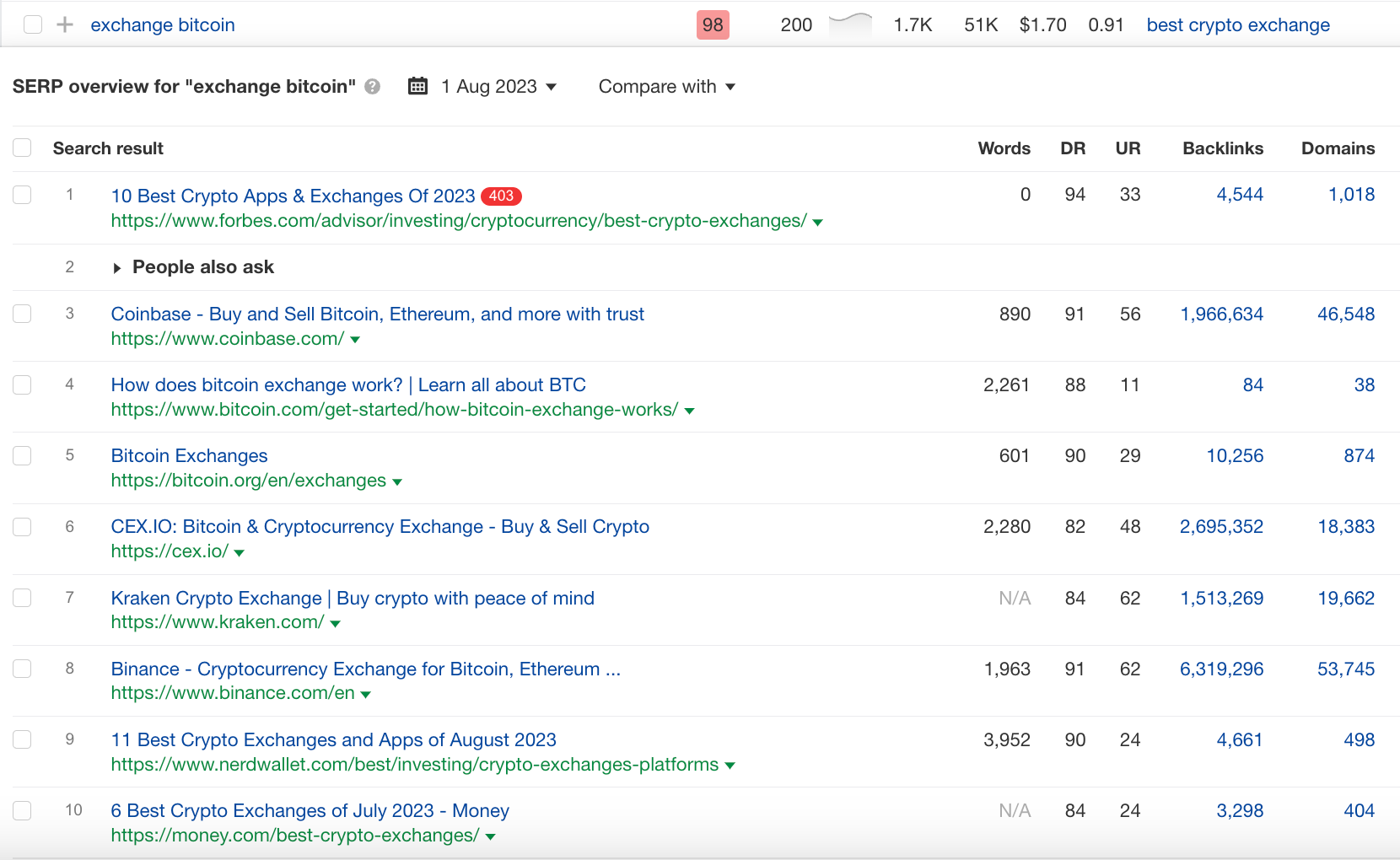
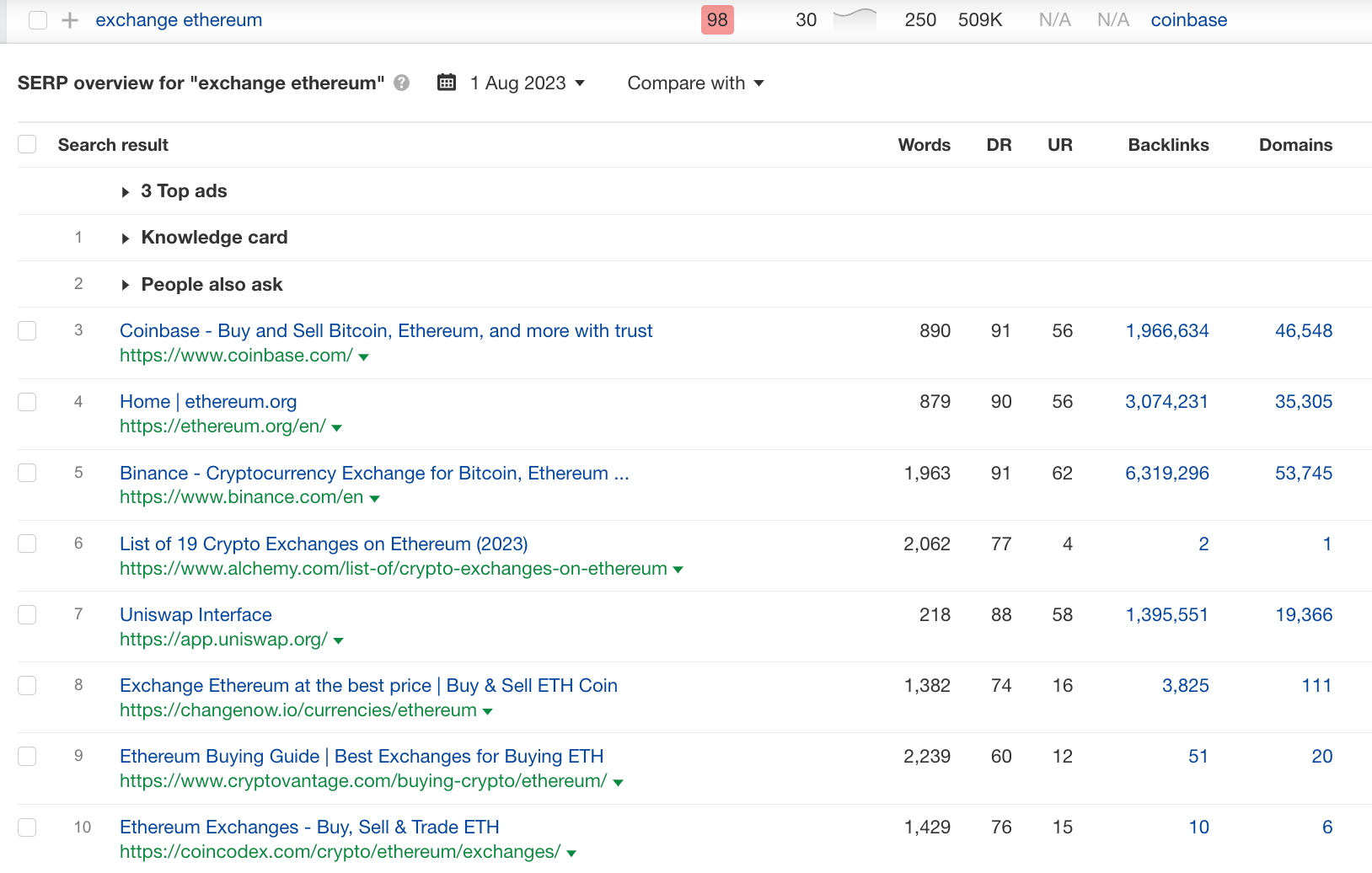
So, analyze the top 10 results and note if you need to optimize your pages (the technical aspects, content, links) or if everything is fine.
Defining Key Performance Indicators (KPIs) for SEO Success
Key performance indicators are crucial for achieving the goals and objectives of your project. In the SEO strategy, these indicators can include traffic volume and the growth of rankings. To define KPIs for your project, you need to set an estimated growth rate of the website metrics according to your goals. They will allow you to keep track of your progress.
KPIs don’t have to be precise since you cannot have a 100% accurate prognosis of what you’ll achieve in 3-6-12 months, but you still have to set goals. As experience shows, KPIs can change in the process according to the way the project progresses. There are different factors that can influence this, such as competition, algorithm updates, implementation speed, and more. They can have both positive and negative impacts on your progress. That’s why KPIs should be reviewed and revised regularly (once in a quarter/a year).
Budget Allocation Strategies for Crypto SEO
This study by Gatner indicates that enterprises allocate 56% of their overall marketing budget to digital marketing channels. Since your crypto website is most likely an entirely web-based business, your digital marketing strategy should account for an even larger spend on SEO and other digital ad strategies.
It’s important to think strategically about your budget for SEO. An effective resource allocation for different SEO strategies and processes should align with your business goals, increase your online presence, and allow for long-term growth.
A significant part of your SEO budget should be directed toward keyword research and content creation, given the highly technical nature of the crypto industry. Inbound links and SEO audits should also be accounted for. One of the most effective budget allocation strategies for crypto SEO is proportional budgeting; however, it’s also important to consider seasonality and the cyclical nature of the cryptocurrency industry.
Proportional Budgeting
Allocating your SEO budget proportionally means dividing your resources to fund different SEO elements based on their importance and potential impact. Here, pay special attention to high-priority elements like on-page optimization, backlink building, technical SEO, content creation, etc.
In order to start budgeting proportionally, you need to decide on the priority that each element of the SEO strategy should be assigned. You will understand which aspects to prioritize after the competitor analysis. Start setting the priorities according to what has to be done first.
If you have a new website that already has content but no backlinks, it’s not necessary to start planning new articles right away. You can first allocate a part of the budget to backlinks and reduce the amount of new content. This way, the website will slowly grow in volume and the quality of on-page optimization will improve, but it will also get backlinks, which will improve the rankings on the existing pages.
On the contrary, if the website doesn’t have quality content yet, then you should focus on creating useful articles. In this case, you should spend less on backlinks but also consider technical optimization.
Let’s analyze a case from our experience. We had a client, a website offering crypto trading bots, who wanted to move up the SERPs right away. However, after a technical audit, we saw that the project had no content, no quality structure, and a lot of mostly spammy backlinks. In addition, Google couldn’t see the source HTML, so they couldn’t get ranked. Thus, we recommended the client first solve the HTML indexing problem, developed a good structure for the site, and provided recommendations on page design and content structuring.
At the same time, we started working on the backlink profile. We removed spammy links and began to build high-quality ones. This helped us promote the brand name and increase the overall SEO metrics of the domain.
Since we knew which pages should be promoted, we started preparing content for them. So, after the client’s development team solved the technical issues, we only had to upload the content to the website.
The largest part of the project budget, which was about 50%, was spent on technical tasks in this case. This was due to the fundamental changes that were implemented and the fact that we had to perform complex audits. About 20% was allocated for backlink profile growth and 30% was directed to content creation. When this stage was completed, we reviewed their budget for SEO and allocated more for backlinks and content development and less for SEO works – 35%, 35%, and 30% accordingly.
Seasonal and Cyclical Considerations: Adapting Budgets for Market Fluctuations
All financial markets follow certain patterns and trends, but the cryptocurrency markets are especially dynamic and dependent on seasonal and cyclical fluctuations. As a crypto business, you should consider the periods of accumulation, markup, distribution, and markdown in your SEO budgeting.
It is important to be flexible in your SEO budget allocation to accommodate market fluctuations, such as during bull and bear markets. During a bullish trend, if you have a well-established brand, there can be a sharp increase in links to your site, so you need to spend more on link audits. And during the bearish periods, there is a decline in user activity, and this is the time to prepare new content and expand the site structure to get more organic traffic.
To be able to adjust your budget in time, stay up to date with the market developments. Monitor your competitors with different tools to see how their metrics shift with market fluctuations. Here is an example of a dashboard for monitoring the current situation in the niche (the main metrics of your competitors):
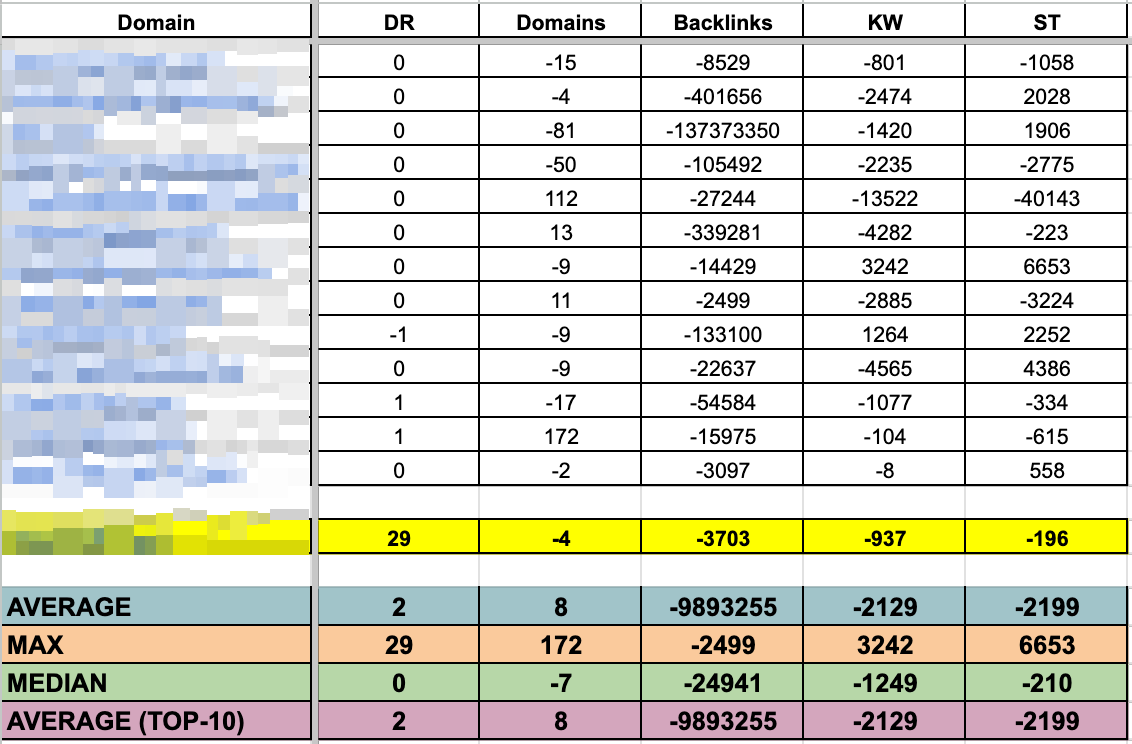
You can benefit from peak seasons and minimize the risks during a downward trend by allocating your resources strategically. It is rather simple: monitor your website’s metrics and the general situation in the field. Allocate funds for the periods with lower demand after the niche analysis. This way, you can foresee different situations in the market and get ready for them.
For example, you can use the Bitcoin Rainbow Chart in addition to your main SEO tools. It shows Bitcoin price cycles, allowing you to see the current condition of the market and when to expect a bull or bear period.

Smart Spending: Tactics for Optimizing Your Crypto SEO Budget
Allocating your SEO marketing budget with thorough planning and smart spending strategies is an effective way to ensure that your marketing efforts generate the best results. There are several tactics you can use to make the most of your SEO efforts and cover all aspects of your SEO spend.
Disclaimer: All the calculations in the following sections are changed to comply with the NDA, but they still convey the main point. So please don’t be too critical about them as our task here is to see an example of the tactic and not accurate data.
Content Creation and Optimization
The main thing to know when it comes to content marketing is that quality is better than quantity. You can always create thousands of pages, filling them with content that is low-quality, AI-generated, or copied from other websites, but this will not bring any good results.
Even if you have a website with a large number of pages, the task of the SEO specialists is to find, for example, 100 pages with the largest potential for getting organic traffic. Start by optimizing them.
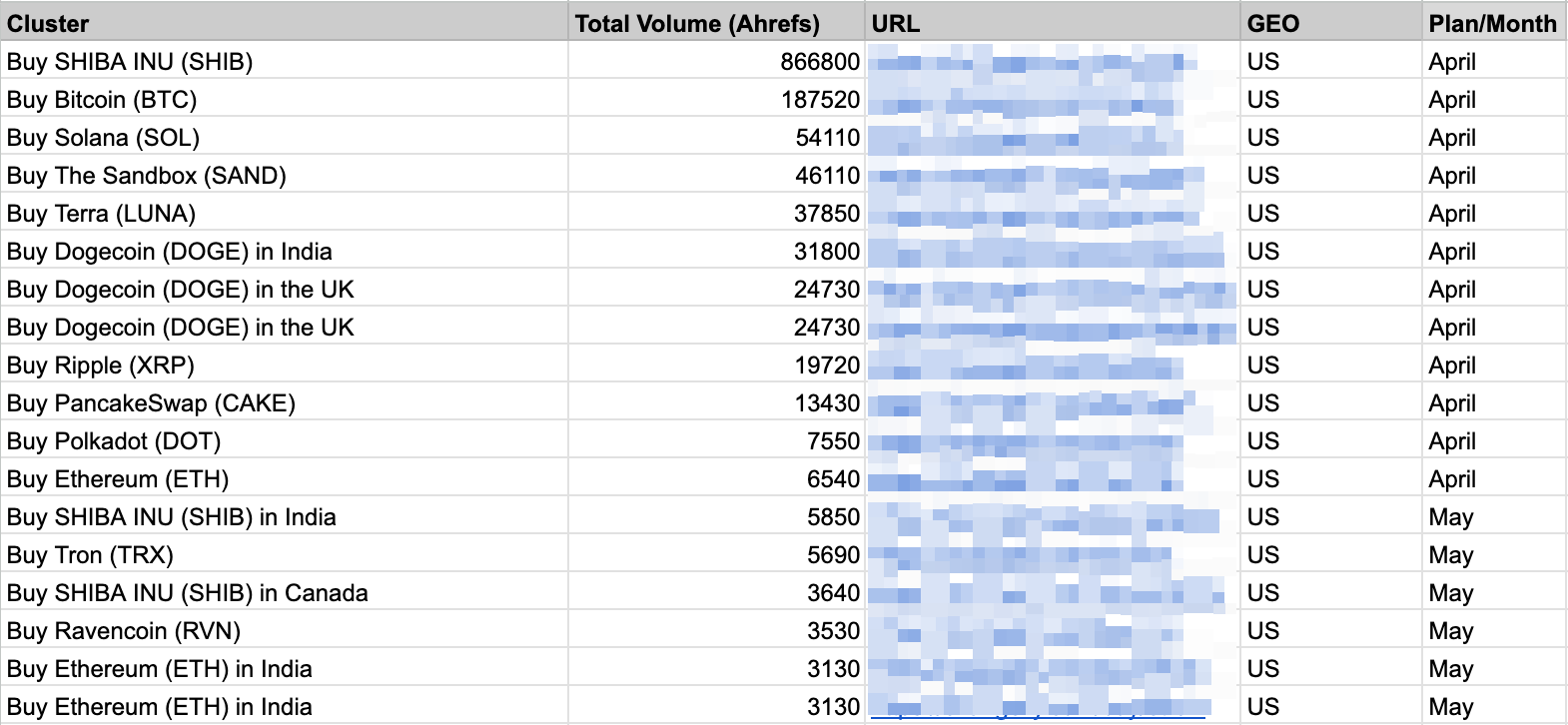
In this screenshot, you can see an example of a content plan for different months, prioritized according to the decreasing search volume of the given cluster. This approach allows you to focus on the pages that can drive the most website traffic. Once you do the first hundred, you can move to the next batch, and so on.
This tactic helps you find out what budget is necessary for a month of content creation and optimization. The example content plan, which included the optimization of 12 commercial pages per month, cost $2,500/month.
Link Building and Outreach
Once you complete a quality niche analysis, you will have a clear understanding of the following:
- The number of backlinks that your competitors have in comparison to your backlink profile;
- The growth rates of these links;
- The quality of the backlinks; and more.
With this data on hand, you will be able to calculate the total number of backlinks you need for keeping the existing search engine rankings and moving up to the top positions. This will also allow you to calculate the rate of backlink profile growth that you need to achieve. For example:
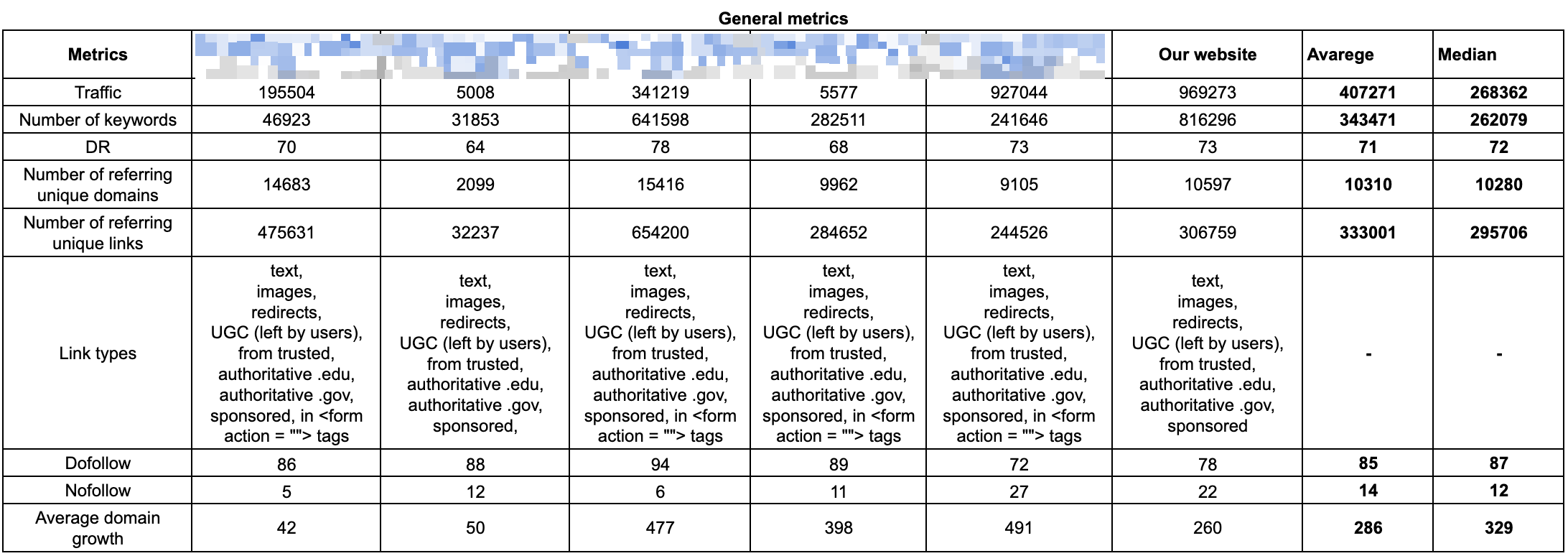
As you can see, three out of five competitors have a higher link number growth per month than our website, with some metrics being twice as high as ours. These are the websites that take the top three positions in most of the important clusters.
Our goal here was to obtain commercial and not informational traffic and the clusters we analyzed were mostly promoted with other methods, not links. Most of our traffic came from blog pages. And most importantly, we had a lot of spam in the backlink profile that was not removed for a long time, which led to such growth rates. When we dug deeper, we saw that we would have to disavow many backlinks.
However, we understood that regular removal of low-quality links will slower the growth rate of the backlink profile, but still a large part of the links obtained organically will remain. Our task was to strengthen the link profile with higher-quality backlinks to improve the rankings in the key clusters.
Analyzing the metrics, we decided that we needed to increase the number of new links to at least 100 per month, but our budget would not be sufficient for that. So, we opted for a more grounded approach, which included 2,5 times fewer links per month that would be distributed among the most important pages and the home page. Our budget calculations summed up to $5,000.
I know it may sound like too much for some projects but it was not like that for a large international exchange website, especially considering that it had been promoted for several years already. And it was less than the $13,000-15,000 we got after the initial estimation.
If you want to do a high-quality audit of your backlink profile, our team of SEO professionals will be happy to help you.
Technical SEO
Your SEO budget will depend on what tasks will have to be done by the SEO consultant (and/or link builder) and how much time it will take for them to research, analyze, and plan. The tasks should be planned according to the monthly workload. Here’s how it may look:
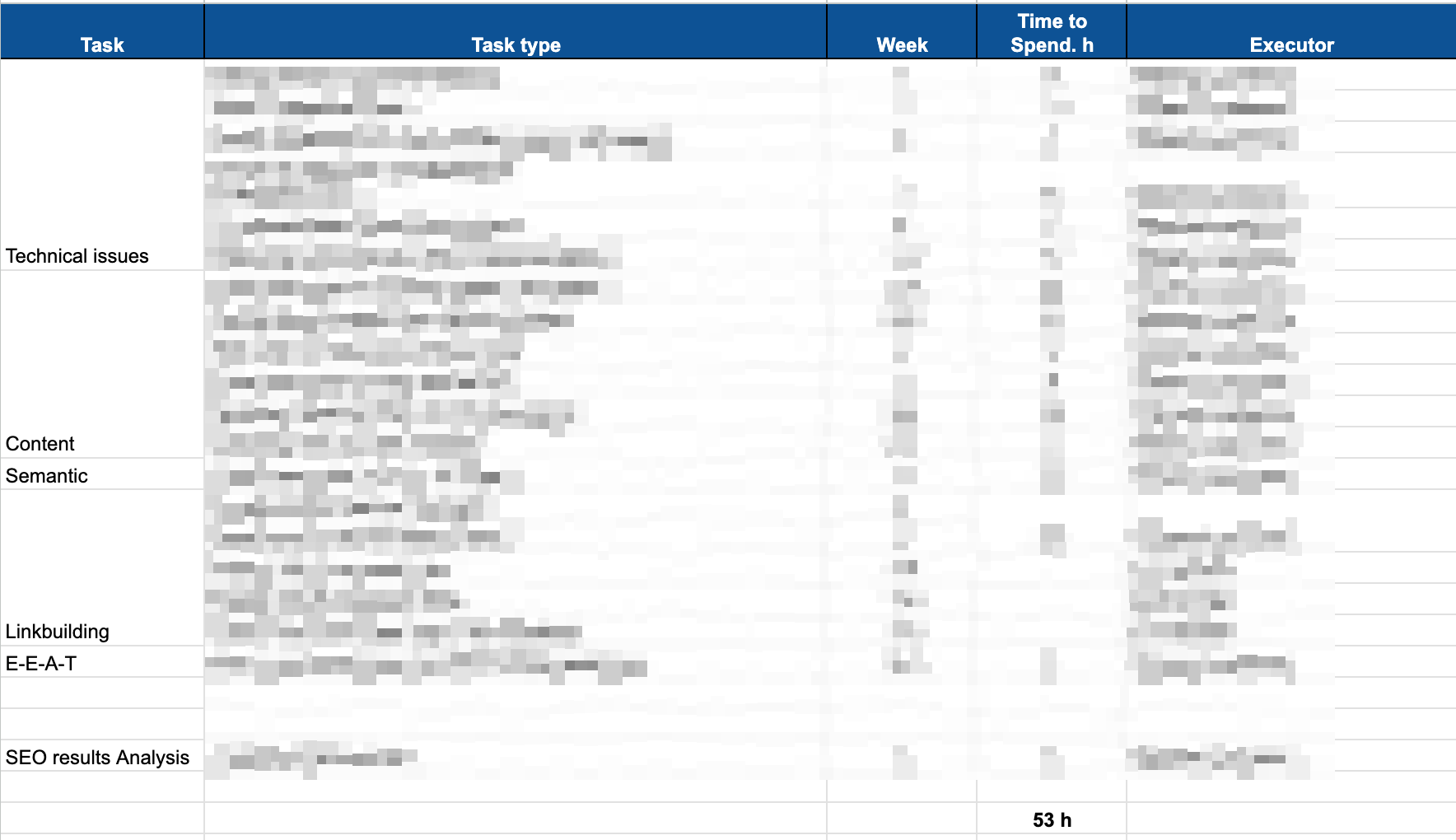
An example of a work plan for a month, with tasks divided per week and work hours.
We can see from this example that we would need approximately 50 hours to complete the technical tasks. Let’s say it would cost about $4,000.
Usually, most of the technical optimization tasks are completed within the first two-three months. When all the main issues are fixed, we can review the planned number of work hours and reallocate the budget toward backlinks or content, if necessary.
SEO Budget Plan creation
The next step is to sum up these calculations, keeping in mind that the SEO budget should remain flexible.

So, if you solve all technical problems over the first three months, you’ll be able to reduce the amount of time required for the project (considering its peculiarities). And the budget can be reallocated for building links. Looks simple, right? However, the main thing comes next.
KPIs and Forecasts
KPI is what allows you to keep track of your progress. Usually, when we speak about metrics to monitor, they include:
- Traffic volume;
- Ranking improvement (for example, ranking in the top 10 results);
- The number of leads.
KPIs can also include the number of backlinks, the number of optimized pages, and so on. Here’s how it can look:
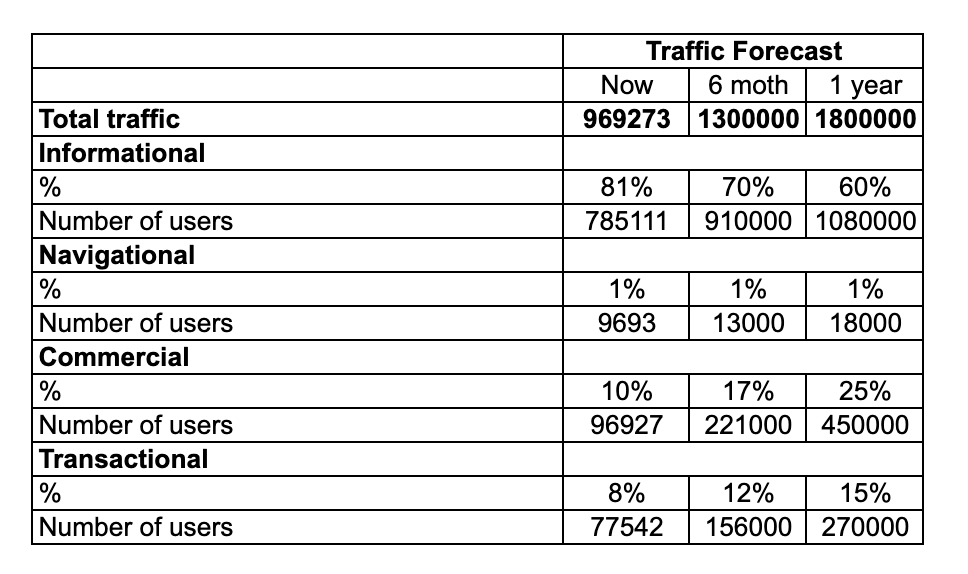
Forecasting methods will be discussed further in our next articles.
Returning to our example, there was a very ambitious goal. It included growing organic traffic volume, namely commercial and transactional traffic.
To create a forecast, we considered seasonality, the condition of the website, the approximate growth rate of keyword volume, and planned works. Two teams were working on the website; one was developing the blog, and the other (our team) was developing the commercial part.
As I said before, it is preferable to check the KPIs each quarter. However, the main checkpoints should be once in half a year. On these checkpoints, the results should be compared with the goals, and the strategy should be reviewed and changed if necessary.
A Little More About SEO Budget
It’s critical to keep in mind that there is no cheap SEO. If an SEO company offers you to do the job cheaply, think twice before accepting the offer.
The SEO budget is typically directly proportional to the among of time and the number of tasks that need to be done. Everything is estimated on a case-by-case basis.
There can be small crypto projects that would only take 20-30 hours per month. If you see low competition in the keyword clusters and the website doesn’t require serious technical optimization, then it may only be necessary to improve the existing pages and add new content. Thus, you will not need so much time.
In this case, you can focus on content creation/optimization, link building, and basic analysis of the following:
- Checking for errors in Google Search Console;
- Regular backlink profile audits;
- Anchor text planning;
- Technical recommendations aimed at ranking improvements;
- Reacting to algorithm updates.
Such projects can have a total budget of around $8,000-10,000/month.
Conversely, there can be projects that will require more than 160 hours of work. Usually, these are crypto exchanges or crypto casinos with strong competition. In this case, you would also need to account for the following:
- Constant monitoring of spammy backlinks;
- The creation of large amounts of content;
- The research of ideas for better on-page optimization and additional content (like charts or FAQ sections);
- Page template revisions;
- Continuous monitoring of pages that generate organic traffic;
- The creation of large anchor text plans for different types of links;
- Timely reactions to algorithm updates.
Such projects can require one or two SEO experts and two to four link builders. Thus, the SEO budget can reach $20,000-30,000/month.
As you see, complex SEO strategies are developed on a case-by-case basis. That is why we recommend analyzing your niche first to avoid unpleasant surprises in the future.
Main Conclusions
When planning out a budget for an SEO campaign in the crypto niche, it is crucial to ensure that it aligns with your broader marketing objectives and existing digital marketing budget. Research the most impactful SEO opportunities and start planning your SEO budget around critical optimization issues.
Begin building your SEO spending plan with a review of your goals and objectives, thorough research of relevant keywords, and an estimation of the KPIs. When allocating your budget, use proportional budgeting methods and take crypto market fluctuations into account.
Lastly, apply smart budgeting tactics according to your project’s needs, regularly audit your website, and check your progress to ensure that you’re moving toward your goals. If you still have any doubts about how to budget SEO for your crypto business, don’t hesitate to contact our crypto SEO marketing agency!








